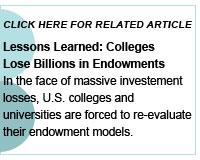Last autumn, as the financial markets were going into free fall, University of Michigan CIO Erik Lundberg received a gift from one of the school endowment fund’s British asset managers. It was a reproduction of a poster created during World War II to help the British people maintain their famously stiff upper lips should the German army invade England. “Stay calm and carry on,” the poster reads. Lundberg immediately taped it to his office door.
“When things were falling apart, people were very concerned,” recalls Lundberg. “They wanted to know what was going on, what would happen to the endowment and to their jobs.”

With a 15 percent unemployment rate and a governor so desperate for revenue that she offered to house inmates from the overcrowded California penal system at a rate of $89 a day, the state of Michigan has arguably suffered from economic hardship longer and more deeply than any other state in the union. Although state appropriations to public colleges and universities increased an average of 49 percent during the past decade, Michigan’s fell by a third. And whereas the average state school counts on these monies for about a third of its operating budget, the Michigan state legislature provides a mere 19 percent of UM’s operating budget.
Constantly managing in crisis mode means that Michigan has had to be creative. “We wanted something that would really insulate us from the volatility in the markets,” says Slottow.
Like most schools, Michigan bases its spending rate in part on investment returns and smooths them out by averaging them over several years. In June 2006 its board of regents approved a decision to increase the spending rate calculation to seven years, up from three. “We had a lot of pushback; a lot of people didn’t think it was the right thing to do,” Slottow allows. That’s because when times are good, school officials often want to spend more, not less, and the new rule prevents that.
The change didn’t insulate Michigan from the markets. The school, which has the seventh-largest endowment in the U.S., with $7.5 billion as of June 30, saw its investments fall by 23 percent for the year ended June 30. Even with that steep loss, Lundberg has managed to navigate the portfolio to a 9 percent annualized return since he started the investment office in 1999.
Communication is critical at Michigan, which has a $5.2 billion operating budget and 40,000 students. The university has formalized a process for coordinating all of its financial decision making. Lundberg and Slottow meet regularly with the comptroller and the treasurer, and their staffs participate in additional meetings. This helped Michigan avoid the problem of potentially running out of cash when the credit markets froze in September 2008, Slottow notes, as the endowment and the treasury worked together to keep 25 percent of total school assets in fixed income.
Unlike many institutions that got caught mid-dig, Michigan insists that all construction funds be identified and set aside before a shovel is put in the ground. This rule has enabled the school recently to complete several building projects, including a new 270,000-square-foot home for its business school and a 53,000-square-foot, $41.9 million addition to its Museum of Art, which doubled its facilities. Next up: Construction is beginning on a $102 million academic addition to the University of Michigan Law School.





